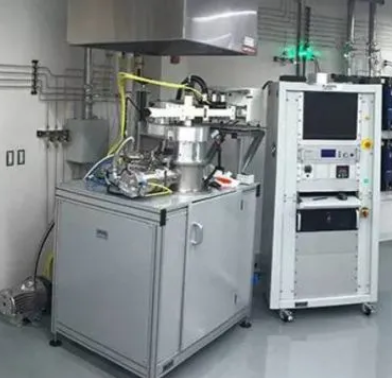
Laboratory hacking technology compresses diamond cultivation time to the extreme
Diamond is a solid form of the element carbon. It has the highest hardness and thermal conductivity of any natural material and is extremely chemically stable, properties that allow it to be used in a wide range of industrial processes such as cutting and polishing tools. According to the process of formation, diamonds can be differentiated into natural diamonds and synthetic diamonds. Natural diamonds are a valuable non-metallic mineral due to their high concentration and the difficulty of mining them, as they are found mainly in central and southern Africa, Australia, Russia and Canada.
Synthetic diamonds are produced in laboratories to simulate the natural formation of natural diamonds. In the 1840s, the United States, Sweden and the Soviet Union conducted systematic research on synthetic diamonds, culminating in the first commercial use of synthetic diamonds in 1954. Synthetic diamonds have the same physical and chemical properties as natural diamonds and are composed of pure carbon in the form of cubic crystals. Unlike natural diamonds, which take millions of years to form naturally beneath the earth's surface, man made diamonds can be grown in a matter of weeks.

Differences between natural and synthetic diamond growth processes
Natural diamonds are grown under a range of temperature and pressure conditions. The temperatures are higher than those used to grow synthetic diamonds. At high temperatures, diamonds grow as octahedral crystals, but at lower laboratory temperatures they grow as crystals containing both octahedral and cubic crystalline faces.
The long growth time of natural diamonds means that the nitrogen impurities in most diamonds must aggregate over a period of time to occur in pairs or clusters, resulting in the majority, or over 95%, of Type Ia diamonds.
Synthetic diamonds have a very short growth period of a few weeks to a month or more, under conditions that are different from those under which natural diamonds form deep within the earth. Due to the very short growth period, the shape of synthetic diamond crystals is very different from that of natural diamonds.
Diamond wire cutting in sapphire, magnetics and semiconductors has significant scope for increased penetration
The market demand for diamond wire cutting in sapphire, magnetic materials and semiconductors continues to open up. In recent years, the rapid development of the LED and consumer electronics industries has led to a growing demand for sapphire, which in turn has led to a continuous rise in demand for diamond wire saws for sapphire cutting. According to Digitimes, global demand for diamond wire saws for sapphire cutting was 1.1 million kilometres in 2017 and is forecast to grow to 1.5 million kilometres by 2020. In the field of magnetic material cutting, the cutting method is in a transition phase from mortar cutting to diamond wire cutting. Magnetic materials are hard, brittle and resistant to sudden changes in temperature, making mechanical processing difficult. At present, a small amount of diamond wire has been used for cutting domestic magnetic materials, and the industry is in the transition stage from mortar cutting to diamond wire cutting. China is a major producer of magnetic materials, and magnetic materials are fundamental to the development of industry and information technology, and are widely used in many fields such as military, aerospace, electronics, automotive and precision manufacturing, etc. Along with the expansion of magnetic material applications and changes in cutting methods, the demand for diamond wire is expected to continue to grow.
From the perspective of semiconductor wafer cutting technology, free abrasive slurry cutting technology is currently mainly used. Semiconductor wafers require high product quality and consistency, and wafer preparation is much more difficult than that of photovoltaic wafers. At present, semiconductor wafer cutting mainly uses the more mature and stable mortar cutting technology, and mainly adopts foreign-made equipment, while the new generation of diamond wire cutting technology is in the verification and promotion stage in the semiconductor wafer manufacturing field. In the future, as diamond wire cutting gradually achieves breakthroughs in the semiconductor wafer cutting process and the technical level of domestic equipment manufacturers improves, domestic diamond wire cutting equipment is expected to start the process of process substitution and import substitution, and the market scale of diamond wire cutting technology is expected to increase significantly. In addition, synthetic diamonds can also be used directly as raw materials for semiconductor devices. According to "Progress in the Preparation and Semiconductor Properties of Type IIb Diamond Single Crystals", diamond has excellent semiconductor properties, and due to its excellent performance in terms of forbidden bandwidth, high breakdown field strength, high carrier mobility, low dielectric constant and good thermal conductivity, diamond can be made into high performance electronic devices that work in harsh environments such as high temperature, high corrosion and high wear. Although diamond semiconductor devices are still in the research stage and no actual production capacity has been released, diamond's excellent physical properties will create applications in specific scenarios as the raw material performance requirements for semiconductor power devices continue to rise.
High Temperature High Pressure (HTHP) and Chemical Vapour Deposition (CVD)
Synthesis methods for synthetic diamonds mainly include High Temperature High Pressure (HTHP) and Chemical Vapour Deposition (CVD), with cultivation times ranging from half a month to one month. The HTHP method is based on the principle of simulating the growth environment of natural diamonds by placing the graphite powder at the bottom of a press and setting the press to constant ultra-high temperature and pressure conditions (typically 5.4 GPa and 1400°C). The solvent metal is melted to give a high purity carbon source, which is transported to the bottom for precipitation to give an artificial diamond. It takes approximately two weeks to grow large rough diamonds over 10 carats using the high temperature and pressure method.
Chemical Vapour Deposition (CVD) synthesis is based on the creation of a high temperature, low pressure (around 1000°C, below 27kPa) environment where carbon atoms from the gas are deposited in crystalline form onto a substrate to interact and grow diamond crystals, mainly in the form of flake diamond films.
Most CVD crystals are brown or grey in colour, but yellow, pink-orange or blue crystals can also be produced if trace amounts of nitrogen or boron are introduced into the vacuum chamber. It is easier to produce colourless crystals by this method, but they take longer to grow. Most CVD-grown colourless diamonds on the market today are thought to be brown crystals that have been decolourised by hot forging at high temperatures and pressures. The most common type of CVD synthetic diamond is Type IIa.
Compared to HPHT grown material, CVD synthetic diamonds exhibit different gemological properties. When viewed between cross-polarisation filters, they tend to show a coloured banded 'stress' pattern with high clarity and only a few dark carbon inclusions.
In chemical vapour deposition (CVD) synthesis, carbon-rich gases are deposited on the surface of flat diamond crystals, resulting in synthetic diamonds.
Synthetic diamonds are grown in thin layers, the final thickness of which depends on the time allowed for growth. This results in flat, plate-like crystals with a black graphite crystal coating on the outside.
As with HPHT synthesis, CVD synthesis continues to improve, allowing manufacturers to offer larger sizes and improved colour and clarity, and the GIA recently examined two large CVD synthetic diamonds weighing 2.51 and 3.23 carats, the largest CVD-grown diamonds examined to date.
High temperature and high pressure (HTHP) is mostly used in the industrial sector due to its lower production costs, faster cultivation rate and lower purity. It is mostly used for functional materials such as light, electricity, sound and diamond jewellery. At present, the HTHP method is mainly used for the production of synthetic diamonds in China, and the CVD method is beginning to be used in China, while countries such as Europe, America, Japan and Singapore have mastered the more mature CVD method.
Lab diamonds are mainly in the form of diamond crystals and cultivated diamonds, with diamond crystals mainly used in industrial production and cultivated diamonds mainly used in fashionable consumer applications. Originally created for industrial production, man-made diamonds are ideal for machine tools and cutting tools as they have the same hardness as natural diamonds. Diamond crystals can be processed into sawing and drilling tools for applications such as engineering and resource extraction, or into diamond micro-powder for use as abrasives in precision machining, photovoltaics and other applications. Compared to natural diamond, man-made diamond is widely accepted and used in the market due to its renewable nature. Due to the immaturity of the technology, nitrogen contamination in the early days of man-made diamond was serious, always yellow to brown in colour, and inclusions were common. As technology progressed and clarity continued to improve, gem-quality cultured diamonds were finally introduced in the early 2000s. Subsequently, the cost of producing gem-quality cultivated diamonds fell rapidly and the rate of market penetration remained high. Although the cultivated diamond industry is still in its early stages of development, the market is rapidly developing in terms of both consumer demand and supply capacity.
These diamonds are so uniform in appearance that it is difficult to distinguish them with the naked eye.
To help the jewellery industry solve this problem, the GIA has recently developed an automated instrument that can detect very small diamonds and will be launching a new testing service at the Appraisal Institute. As part of an ongoing research project into synthetic diamonds, the GIA has recently established a CVD growth laboratory where it is able to produce its own synthetic diamonds for use in research.
Global rough diamond production declined from 150 million carats to 120 million carats between 2018 and 2021. The largest producer by value, 8 of the 10 largest producing countries experienced declines in production, with only South Africa and Zimbabwe registering increases.
Rough diamond supply outstripped demand, resulting in a greater year-on-year increase in the price of large carat finished diamonds. As diamond production declined, diamond prices continued to rise. De Beers, the world's largest diamond mining supplier, increased the price of rough diamonds by approximately 8% at its first trade fair in 2022, the fifth time since December 2021. The price index for finished diamonds jumped by 5.67% in the first month of 2022, the largest one-month increase in many years. Diamond prices declined in June due to relatively weak global economic expectations and an overall increase in finished diamond stocks, but still showed a significant year-on-year increase. According to Rapaport, the one-carat RAPI price index fell by 1.8% in June and rose by 16.8% year-on-year.
Man made diamonds offer an advantage in terms of value for money compared to natural diamonds, due to the continued expansion of cultivated diamond production capacity and decreasing production costs. As at the end of 2020, the price of cultivated diamonds is only 1/3 of that of natural diamonds, and after further price increases for finished diamonds in 2021, the price ratio of cultivated diamonds to natural diamonds is likely to decline further.
Industry barriers are high, and companies with technical and financial advantages are expected to enjoy more dividends
The industry barriers are high and the rate of capacity expansion is limited, so companies with technical and financial advantages are expected to enjoy high growth dividends in the early stage of the industry. The demand for man-made diamonds has been booming in recent years, and the supply side is also actively expanding, but due to the overall high barriers in the industry, there are more restrictions on the expansion of production enterprises and the speed of capacity expansion. We believe that the industry barriers are mainly focused on two major factors, namely technology and capital.
(1) Technical barriers: Initially, man-made diamond products were mainly used in the engineering manufacturing sector, which is a simple processing industry with limited requirements for production technology. As the industry develops and technology advances, the penetration rate of man-made diamond products in the precision industry and fashionable consumer sector is increasing, which places high demands on the technological reserves of enterprises. At present, Chinese manufacturers basically use the HTHP method to produce cultivated diamonds, with the synthetic grain size mainly in the 1-3ct range, and the synthetic products are often grainy and of poor clarity. The development of such technologies is the result of long-term accumulation by manufacturers, and it is difficult for small manufacturers to replicate and copy them.
(2) Financial barriers: According to the company announcements of Power Diamond and Guoji Jingong, the price of a single unit of six-sided top press equipment is about 1-2 million. According to the China Machine Tool & Tool Industry Association (CMTIA), under the same synthesis environment, the average output of high grade diamond single crystals synthesized by a φ650 type six-sided top press is about 200ct/time, that of a φ700 type six-sided top press is about 280-320ct/time, that of a φ800 type (casting) six-sided top press is about 320-360ct/time. The larger the cylinder bore, the higher the single synthetic diamond production, and therefore the bore of domestic mainstream six-sided top presses is increasing. However, the larger the bore, the more difficult it is to produce the presses.
Therefore, the price of forged φ800 type, cast φ800 type and upgraded models is relatively higher, with the price of the main machine being about RMB1.1-1.3 million each and the price of the whole set of six-sided top presses about RMB1.5-1.7 million. According to the report of the reply to the Power Diamond's fixed increase inquiry letter, the company's single annual order quantity will reach 700-1200 units in the next three years, and the single annual order amount will reach RMB 770-1.56 billion. This shows that the industry has a strong asset-heavy nature and requires a high level of capital from manufacturers. As the only listed company producing six-sided top presses in the industry, the current capacity of six-sided top presses is only 200-300 units per year, and the capacity of six-sided top presses is also one of the factors limiting the rate of capacity expansion in the industry.











